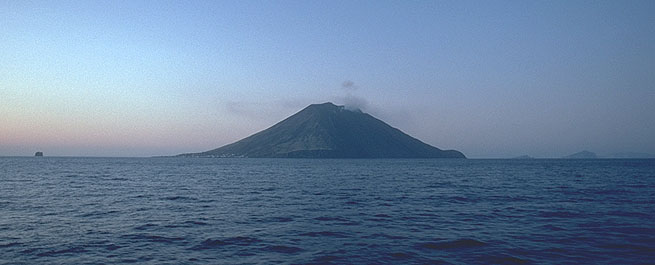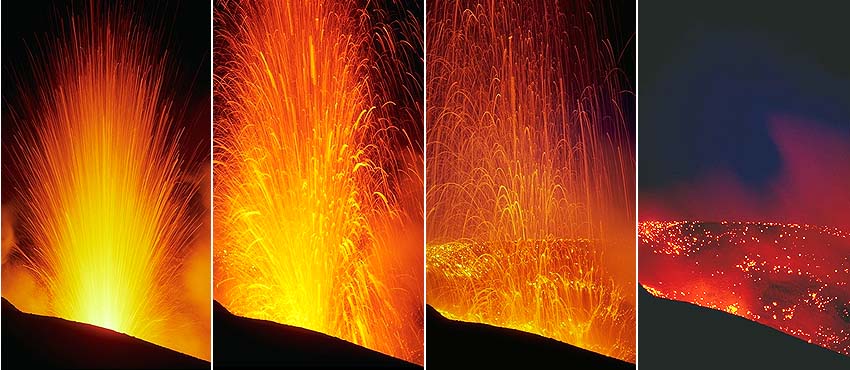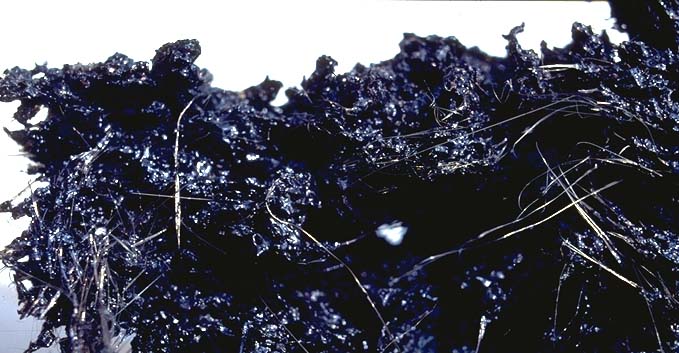 The island of Stromboli from the North. During the approach with the ship from Naples, roughly half an hour before sunrise. Sometimes it is possible to see the eruptions already from this distance. On the left is Strombolicchio, an old, extinct volcanic vent. On the right, in the far distance, notice the island of Panarea. |  Ash eruption of crater 1 observed from the North (regular route to summit, approximately 700m.a.s.l.). July 1986. |  Eruption of crater 2, April 1979. In the full picture you can see two persons. They are standing roughly halfway between us and the edge of the erupting crater. IMPORTANT: It is extremely dangerous to approach the craters on Stromboli. The eruption shown here reached at least 250 metres above the visible crater edge. |  Eruption of crater 1, September 1984. We took this picture at about 700m.a.s.l. from the regular route to the summit after waiting for many hours in fog. Only long after midnight did the fog clear away. We can see how the ejected lava falls onto the 'Sciara del fuoco' on which it will slide towards the sea. |
 Small ash eruption of crater 1, as seen from the ridge south of the summit (April 1979). Crater 3 is on the front left, crater 2 behind it. Because of dry air conditions and wind from behind, visibility is very good. However, the view down to the crater terrasse can be hampered considerably by steam and smoke in other situations. |  Eruption of crater 1 in moonlight. October 1986, from approximately 700m.a.s.l. (regular summit route). This image was taken during full moon in October 1986. After the eruption had terminated, the camera shutter was kept open for several minutes in order to capture the weak sky light and some of the landscape. During this time crater 3 also erupted (right background). However, the two eruptions did not occur simultaneously. The small bright lines in the sky are stars which trailed during the exposure time as a result of the Earth's rotation. |  Typical sequence of an eruption of crater 3. October 1986, camera position: Stromboli summit. Whereas most of the other pictures presented here were taken with a standard (50mm) camera lens, this series was recorded with a 135mm telefoto lens. The left image shows the first few tenths of a second of the eruption. Lava is violently thrown out. In the second image the eruption has reached its climax and in the third, most of the lava is already falling back into the crater. The final image shows tha lava cooling and its glow slowly fading. |  People at the edge of crater 3. April 1979. These visitors are standing right on the edge of the crater which produces a small eruption just now. On this day most major eruptions came from crater 2, which is further back. BEWARE: The size AND the direction of the explosions on Stromboli can change unexpectedly and rapidly. It is very dangerous to go near the craters! |
 On the edge of crater 3. For this picture the camera was placed no more than a few meters from the edge of crater 3 (July 1981). |  A view of the interior of crater 3. From the summit of Stromboli you cannot see the very bottom of the craters. In order to take these pictures we once risked going up to the crater's edge. We were there for a brief time only, and it was most uncomfortable (July 1981). Nowadays we consider this much too dangerous and we would not do it anymore. The eruption shown here is only very small. The lava did not fly higher than a few dozen metres above the edge of the crater. Nevertheless the heat radiation was strongly noticeable. After the eruption (picture at right) the cinders are lying on the crater floor and wall, cooling and ceasing to glow. The diameter of the vent (visible only in the right picture) is only one or two metres. |  Freshly ejected lava from crater 3. This sample was collected immediately after it had cooled sufficiently for handling. Hot, fresh lava produces thin strands. Because they break very easily weathering soon destroys them. Therefore they cannot normally be seen on older Stromboli lavas. The picture is only about 5cm wide (July 1981).
| |